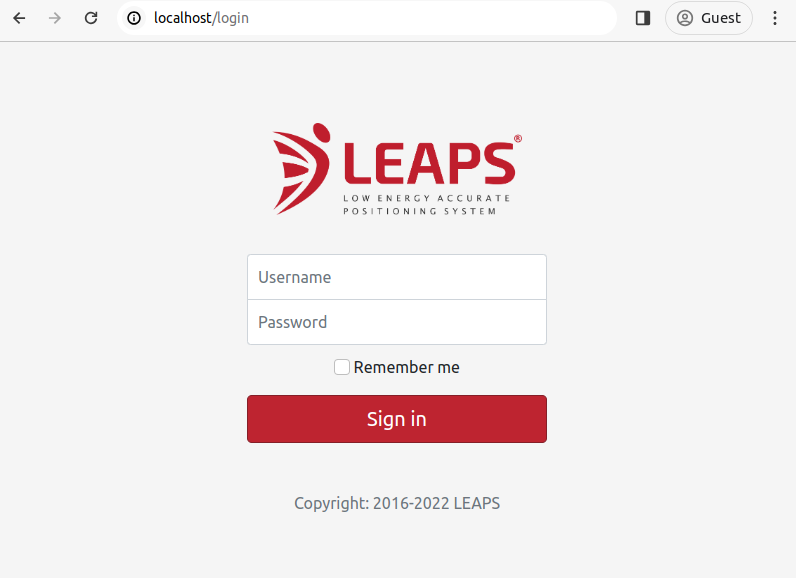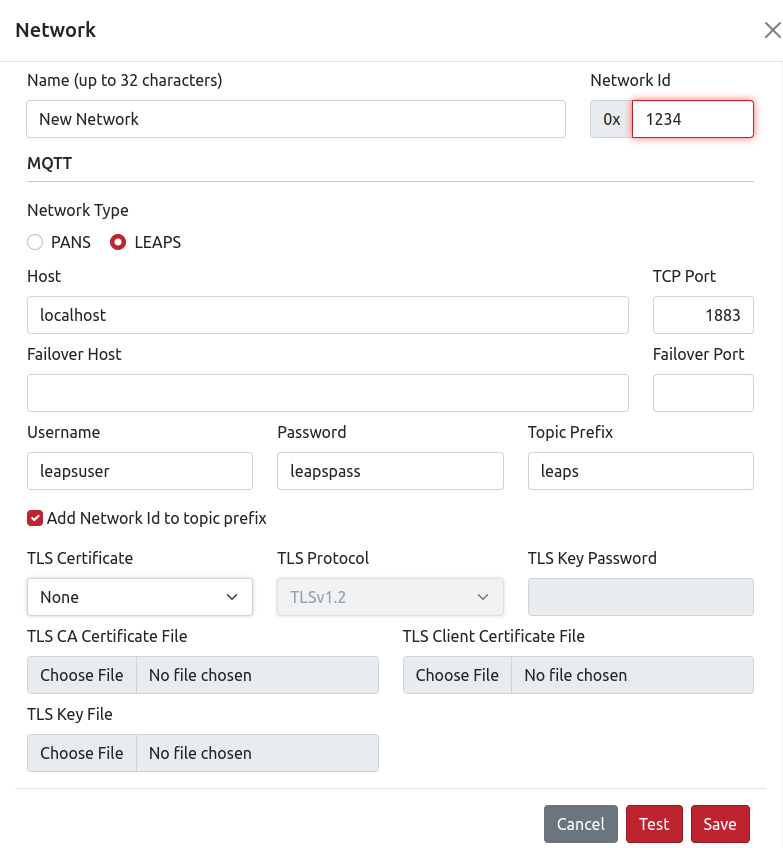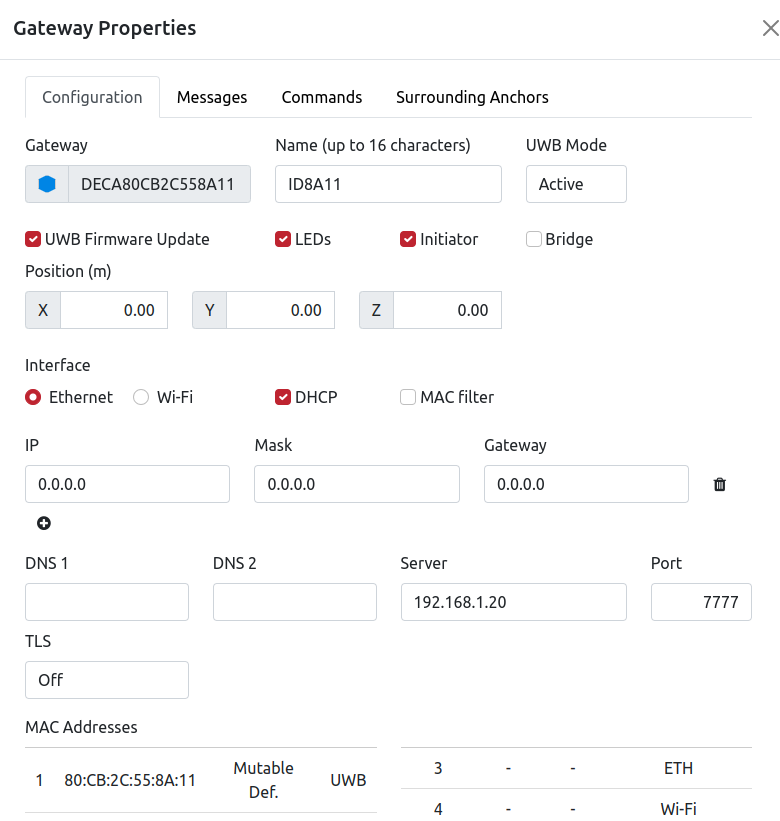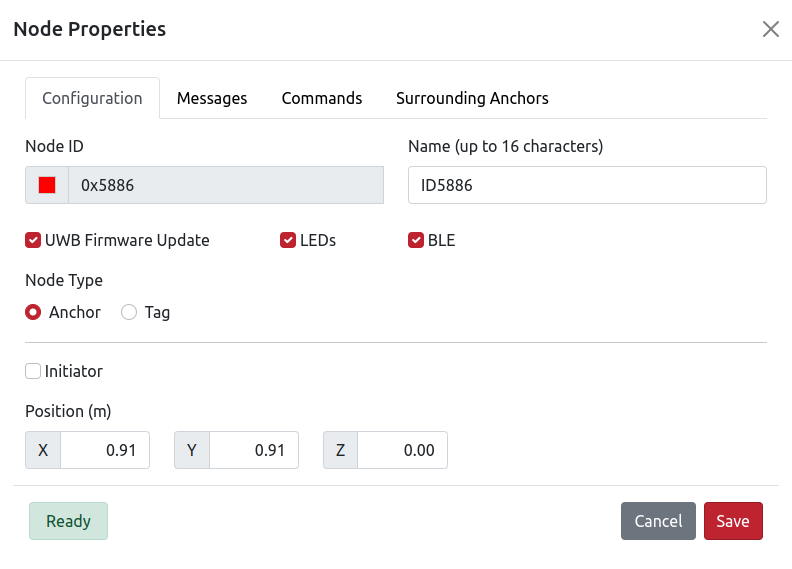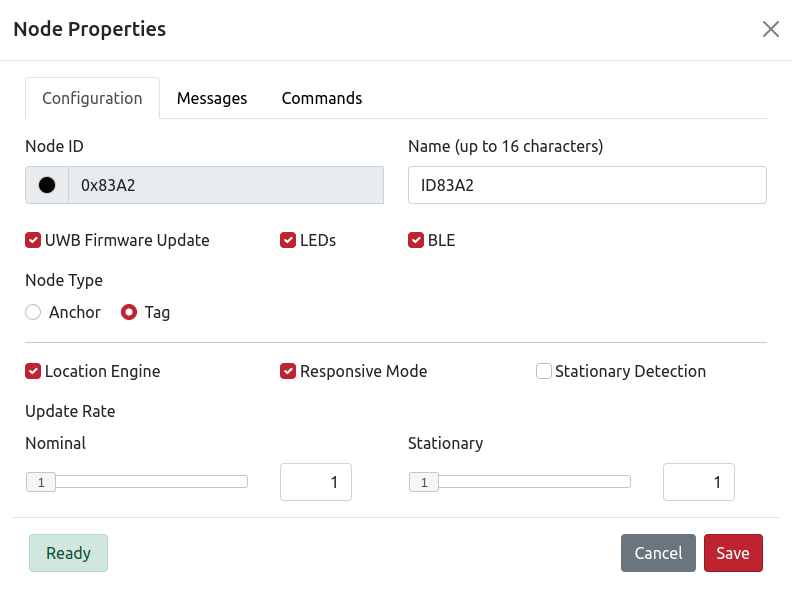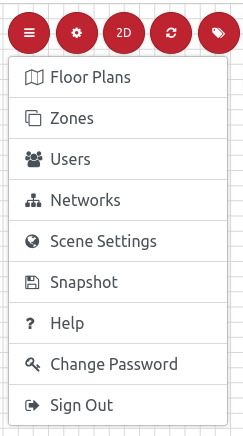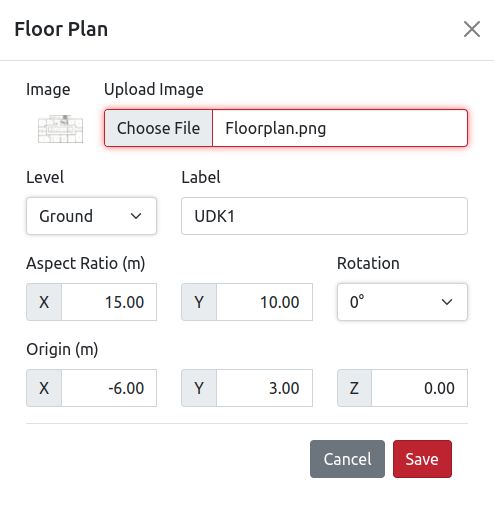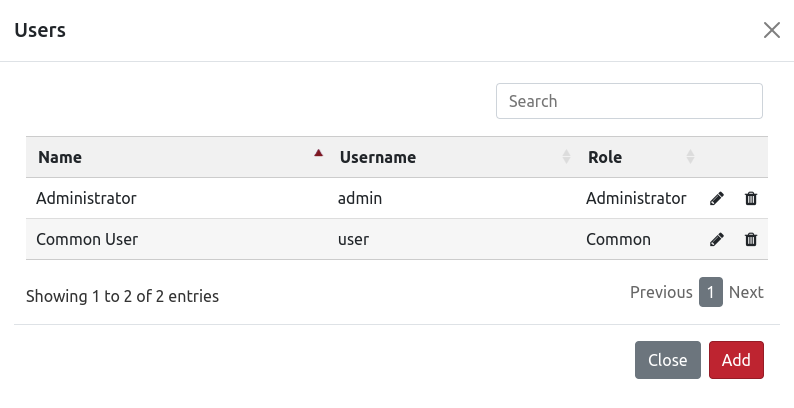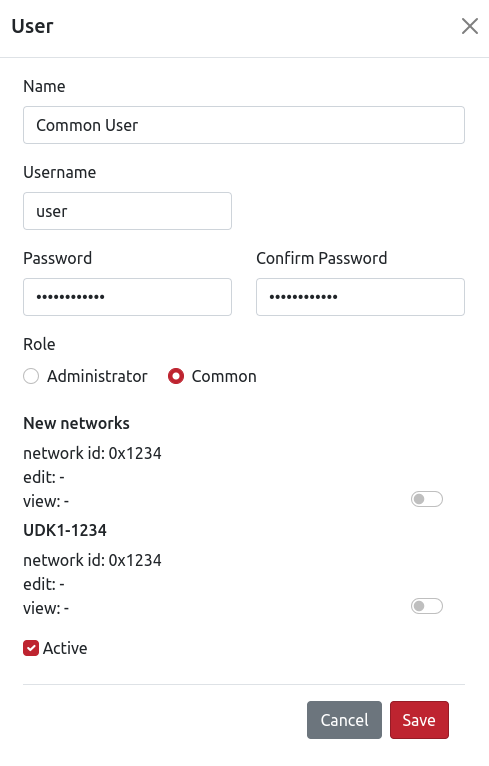LEAPS 中心
LEAPS 中心 是一个网络应用程序,提供设备管理, 网络管理以及整个网络的位置和遥测数据的可视化.
主要功能
2D和3D网格提供实时位置更新,并将网络中的设备可视化.
其他有用的功能包括用户管理, 区域管理, 区域历史, 平面图管理, 位置历史和位置热图.
The LEAPS 中心 通过 MQTT Broker 与 LEAPS 服务器 互联. 它作为一项服务在 Linux 和 Windows 上运行
安装
系统要求
Docker的系统要求因操作系统而异.
对于 Linux,您需要 64 位架构, 兼容的内核版本和特定的内核功能.
在 Windows 上,在启用虚拟化的 Windows 10上使用 Docker Desktop
在 macOS 上,请使用配备 macOS 10.13 或更新版本的Docker Desktop. 在硬件方面,建议至少配备 2GB 内存以及足够的 CPU 和磁盘空间.
注解
有关最新详情,请参阅 Docker 官方文档.
说明
在电脑上安装 Docker
此外,您还可以参考以下命令进行安装:
curl -fsSL https://get.docker.com -o get-docker.sh sudo sh ./get-docker.sh sudo usermod -aG docker $USER
准备配置软件包
创建包含 配置文件 的 leaps_center 目录
leaps-center-web.conf
应用程序.属性
leaps-center-history.properties
leaps-center-web.properties
或者下载 LEAPS 中心 配置包 (LEAPS_CENTER_DOCKER.zip).
在电脑上打开命令提示符或终端窗口.
安装 LEAPS 中心 Docker 软件包并运行:
docker run -d -p 80:8080/tcp --name some_name -v /path/to/data/data/:/app/data/ -e LEAPS_CENTER_HOME=/app/data/ leapslabs/leaps_center:tag sh -c "cd /app && java -jar leaps-center-web.jar"其中
some_name是要分配给容器的名称,tag是指定要使用的leaps-center-web版本的标记.leaps_center 映像必须与外部挂载的文件夹一起运行,该文件夹包含配置文件以及应用程序日志和配置/节点历史数据库的空间.
选项
-v /path/to/data/:/app/data/将位于/path/to/data/的文件夹挂载到内部的/app/data文件夹. 数据文件夹必须包含以下文件.
推荐的运行选项
--user $(id -u):$(id -g)在特定用户和组下运行实例.
--restart unless-stopped在服务器崩溃时自动重启实例.可选运行选项
--security-opt seccomp=unconfined在 32 位 Raspberry Pi 镜像(Raspbian)上需要这个选项,因为它包含一个过时的 seccomp 库,其中的一个错误会对 Docker 镜像产生负面影响(无法连接到 MQTT 服务器). 该选项允许我们覆盖这一问题.
LEAPS 中心 安装过程将开始。
例如,在 Ubuntu (Linux) 上:
docker run -d -p 80:8080/tcp --name leaps_center -v $PWD/leaps_center/:/app/data/ -e LEAPS_CENTER_HOME=/app/data/ leapslabs/leaps_center:latest sh -c "cd /app && java -jar leaps-center-web.jar" Unable to find image 'leapslabs/leaps_center:latest' locally latest: Pulling from leapslabs/leaps_center a458657ccc71: Pull complete Digest: sha256:a19b127656d41d8607f043c2c83924e5b9a5cbd4dc23cfbed070be3b9cfc6b9a Status: Downloaded newer image for leapslabs/leaps_center:latest 320d3768289874e063619f75faca7a24dd75a08884df8cd8fb2cc9b54c6f0a46
确认安装成功,运行:
例如,在 Ubuntu (Linux) 上:
docker ps CONTAINER ID IMAGE COMMAND CREATED STATUS PORTS NAMES b1145b72db35 leapslabs/leaps_center:latest "sh -c 'cd /app && …" 37 seconds ago 11 seconds ago leaps_center
打开web浏览器并输入以下内容 http://localhost:80; 将在web浏览器中加载 LEAPS 中心 应用程序。
因此,您已在PC上成功安装并启动 LEAPS 中心。
配置文件
leaps-center-web.conf
JAVA_OPTS="-Xms256m -Xmx512m -Xss256k"应用程序.属性
leaps-center-history.properties
leaps-center-web.properties
该配置文件控制应用程序日志记录.
spring.main.banner-mode=OFF logging.level.root=OFF logging.level.global.leaps.center.mqtt=OFF logging.level.global.leaps.center.init=OFF logging.level.global.leaps.center.service=OFF logging.level.global.leaps.center.history.filter=OFF logging.level.global.leaps.center.history.service=OFF logging.level.global.leaps.center.history=OFF logging.level.global.leaps.center.web.component=OFF logging.level.global.leaps.center.web.rest=OFF logging.level.global.leaps.center.web.sse=OFF logging.level.global.leaps.center.web=OFF logging.level.global.leaps.center=OFF
该配置文件控制节点位置历史记录.
# # LEAPS - Low Energy Accurate Positioning System - LEAPS Center. # # Copyright (c) 2016-2021, LEAPS. # # Licensed under the Apache License, Version 2.0 (the "License"); # You may not use this file except in compliance with the License. # You may obtain a copy of the License at # # http://www.apache.org/licenses/LICENSE-2.0 # # Unless required by applicable law or agreed to in writing, software # distributed under the License is distributed on an "AS IS" BASIS, # WITHOUT WARRANTIES OR CONDITIONS OF ANY KIND, either express or implied. # See the License for the specific language governing permissions and # limitations under the License. # # history enabled (default false) history.enabled=false history.position.enabled=true history.zone.enabled=true # use node position message timestamp (default true) history.use.position.timestamp=false # ======================================================================================================= # Export Options # ======================================================================================================= # add headers (default false) history.export.headers=false # maximum number of records (default 1000000) history.export.max.lines=1000000 # compress export file (default true) history.export.compress=true # number of decimal places for x, y, z values (default 4) history.export.position.decimal.places=2 # format network id to hex value (default true) history.export.hex.network.id=true # format node ID to hex value (default true) history.export.hex.node.id=true # ======================================================================================================= # Position History Options # ======================================================================================================= # interval time to add a history record (default 10000) history.node.position.interval.time=10000 # minimun quality value (default 0) history.node.position.min.quality=0 # ======================================================================================================= # Heatmap Options # ======================================================================================================= # maximum number of records for heatmap (default 100000) heatmap.max.results=100000 # ======================================================================================================= # Purge Options # ======================================================================================================= # time to purge database records in days (default 30 days) history.purge.time=30 # backup purged records to a file in /history folder (default false) history.purge.backup.records=true # max number of backup files (default 10) history.purge.max.backup.files=5 # ======================================================================================================= # DBMS (SQLITE, POSTGRESQL, MY_SQL, ORACLE, SQL_SERVER or CUSTOM) # ======================================================================================================= # History - SQLite Database Example (default). # history.dbms=SQLITE # history.db.jdbc.url=jdbc:sqlite:leaps-center-history.db # history.db.username= # history.db.password= # History - PostgreSQL Database Example # history.dbms=POSTGRESQL # history.db.jdbc.url=jdbc:postgresql://localhost:5432/leaps_center_history # history.db.username=leaps_center # history.db.password=pwd # History - Oracle Database Example # Important! To use Oracle DBMS is mandatory to change global.leaps.center.history.entity.NetworkNodeHistory.id @Id generation strategy to GenerationType.AUTO or GenerationType.SEQUENCE. Oracle does not support GenerationType.IDENTITY. # history.dbms=ORACLE # history.db.hibernate.dialect=org.hibernate.dialect.Oracle10gDialect # history.db.jdbc.url=jdbc:oracle:thin:@127.0.0.1:1521/XE # history.db.username=leaps_center # history.db.password=pwd # History - MySQL Database Example # history.dbms=MY_SQL # history.db.jdbc.url=jdbc:mysql://localhost:3306/leaps_center # history.db.username=leaps_center # history.db.password=pwd # History - SQL Server Database Example # TODO: It needs to be tested. # history.dbms=SQL_SERVER # history.db.jdbc.url=jdbc:sqlserver://localhost:1433;databaseName=leaps_center_history;integratedSecurity=true # history.db.jdbc.url=jdbc:jtds:sqlserver://localhost:1433/leaps_center_history;instance=SQLEXPRESS; # history.db.username=leaps_center # history.db.password=pwd # History - Custom Database # history.dbms=CUSTOM # Hibernate Dialect # history.db.hibernate.dialect=org.hibernate.dialect.PostgreSQLDialect # JDBC driver class # history.db.jdbc.driver.class=org.postgresql.Driver
该配置文件控制 leaps_center 应用程序.
# # LEAPS - Low Energy Accurate Positioning System - LEAPS Center. # # Copyright (c) 2016-2021, LEAPS. # # Licensed under the Apache License, Version 2.0 (the "License"); # you may not use this file except in compliance with the License. # You may obtain a copy of the License at # # http://www.apache.org/licenses/LICENSE-2.0 # # Unless required by applicable law or agreed to in writing, software # distributed under the License is distributed on an "AS IS" BASIS, # WITHOUT WARRANTIES OR CONDITIONS OF ANY KIND, either express or implied. # See the License for the specific language governing permissions and # limitations under the License. # # database (SQLITE, POSTGRESQL, MY_SQL, ORACLE, SQL_SERVER or CUSTOM) db.dbms=SQLITE # History - SQLite Database Example. # dbms=SQLITE # db.jdbc.url=jdbc:sqlite:leaps-center-db # db.username= # db.password= # History - PostgreSQL Database Example # db.dbms=POSTGRESQL # db.jdbc.url=jdbc:postgresql://localhost:5432/leaps_center # db.username=postgres # db.password=qwe123 # History - Oracle Database Example # Important! To use Oracle DBMS is mandatory to change global.leaps.center.entity.NetworkNodeHistory.id @Id generation strategy to GenerationType.AUTO or GenerationType.SEQUENCE. Oracle does not support GenerationType.IDENTITY. # db.dbms=ORACLE # db.hibernate.dialect=org.hibernate.dialect.Oracle10gDialect # db.jdbc.url=jdbc:oracle:thin:@127.0.0.1:1521/XE # db.username=leaps_center # db.password=q1w2e3r4t5 # History - MySQL Database Example # db.dbms=MY_SQL # db.jdbc.url=jdbc:mysql://localhost:3306/leaps_center # db.username=root # db.password=qwe123 # History - SQL Server Database Example # db.dbms=SQL_SERVER # db.jdbc.url=jdbc:sqlserver://localhost:1433;databaseName=leaps_center_history;integratedSecurity=true # db.jdbc.url=jdbc:jtds:sqlserver://localhost:1433/leaps_center_history;instance=SQLEXPRESS; # db.username=leaps_center # db.password=qwe123 # History - Custom Database # db.dbms=CUSTOM # Hibernate Dialect # db.hibernate.dialect=org.hibernate.dialect.PostgreSQLDialect # JDBC driver class # history.db.jdbc.driver.class=org.postgresql.Driver # db.jdbc.url=jdbc:postgresql://localhost:5432/leaps_center # db.username=postgres # db.password=qwe123 # db.jdbc.driver.class= # db.hibernate.dialect= # show sql (default false) # db.jpa.show-sql=false # format sql (default false) # db.jpa.format-sql=false # ======================================================================================================= # network # ======================================================================================================= # enable the registration of networks with mqtt connection type = HOST. (default true) network.mqtt.connection.by.host.enabled=true # enable the registration of networks with mqtt connection type = PAN_ID. (default false) network.mqtt.connection.by.network.id.enable=false # enable the registration of networks with web client connection by websocket. (default false) network.web.client.connection.by.web.socket=false # create the default network if it does not exist when starting. (default true) network.create.default.network=true # network.create.default.floor.plan=true network.default.id= network.default.name=Default # PAN_ID or HOST network.default.mqtt.connection.type=HOST # WS or SSE network.default.web.client.connection.type=SSE # MQTT mqtt.host= mqtt.ws.port=15675 mqtt.tcp.port=1883 mqtt.username=dwmuser mqtt.password=dwmuser # Enable/Disable TLS #mqtt.tls= # CA_SIGNED_CERTIFICATE (signed by a publicly trusted CA), CA_FILE_CERTIFICATE (file certificate); #mqtt.tls.certificate.type=CA_SIGNED_CERTIFICATE # TLS Protocol: TLS_V1 (TLSv1), TLS_V1_1 (TLSv1.1), TLS_V1_2 (TLSv1.2), TLS_V1_3(TLSv1.3); #mqtt.tls.protocol=TLS_V1_2 #mqtt.tls.certificate.file=/user/.../leaps-center.crt mqtt.topic.prefix=dwm mqtt.tag.topic.prefix=node mqtt.anchor.topic.prefix=node # ======================================================================================================= # floorplan settings # ======================================================================================================= # size in pixels (default 2048) floorplan.max.image.dimension.size=2048 # ======================================================================================================= # scene settings # ======================================================================================================= # size in cm (default 50cm) scene.grid.size=50 # color in int (default 0xD8D8D8) scene.grid.color=0xD8D8D8 # max grid visibility distance in meters (default 100) scene.grid.max.visibility.distance=100 # zoom min in meters (default 2) scene.zoom.min=2 # zoom max in meters (default 100) scene.zoom.max=100 # ======================================================================================================= # web server settings # ======================================================================================================= # http session timeout server.servlet.session.timeout=120m # maximum number of http sessions per user (-1 is unlimited) server.max.sessions.per.user=-1 # mod-jk/ajp connector configuration tomcat.ajp.enabled=false # tomcat.ajp.port=8009 # tomcat.ajp.secret.required=false # tomcat.apr.enabled=false # server port (2-65535) server.port=8080 # enable / disable https server.ssl.enabled=false # keystore format # server.ssl.key-store-type=PKCS12 # keystore location # server.ssl.key-store=D:\\Leaps\\tls\\springboot.p12 # keystore alias # server.ssl.key-alias=springboot # keystore password # server.ssl.key-store-password=password # SSL protocol to use # server.ssl.protocol=TLS # Enabled SSL protocols # server.ssl.enabled-protocols=TLSv1.2
开始
默认情况下,登录账户的用户名为 admin,密码为 admin.
LEAPS 服务器 Docker
网络配置
要配置网络,请进入菜单并选择 Networks.
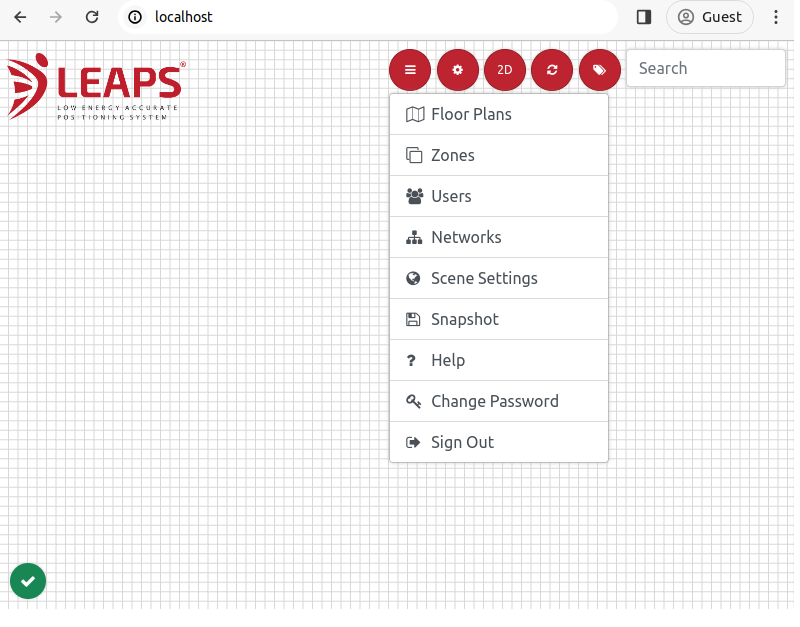
网络管理对话框将弹出. 默认情况下已经设置了本地主机网络,网络 ID 为 0x1234.

要创建新网络,请单击右下角的 Add 按钮.
现在,填写所需的配置参数:
如果不知道网络 ID,可以使用 LEAPS 管理器 或 Shell 查找.
最后,您可以单击 Test 按钮检查连接情况,然后单击 Save 按钮保存配置.
平面图
区域
用户
应用程序接口授权
用户需要向/login发送一个简单的HTTP POST,并传递以下参数(以admin:admin为例).
用户名: admin
密码:admin
记住我:开启
登录后会生成 JSESSIONID cookie,用户需要在后续请求中使用它.
注解
这不是强制性的,如果用户使用了它,会在响应中添加另一个 cookie(cookie REMEMBERME),用户可以在后续请求中使用它.
由于 LEAPS 中心 在登录后以及用户未经授权时执行重定向,因此有必要在用户的客户端中正确设置”跟随重定向” 参数。登录后的响应码为302,但用户需要手动处理,因为如果用户未获得授权,状态码也为302。例如,用户可以向REST服务发出任何请求,如果响应状态代码不是200,则用户将不会被授权。
下面是一个用 Java 编写的请求和查询网络的代码示例:
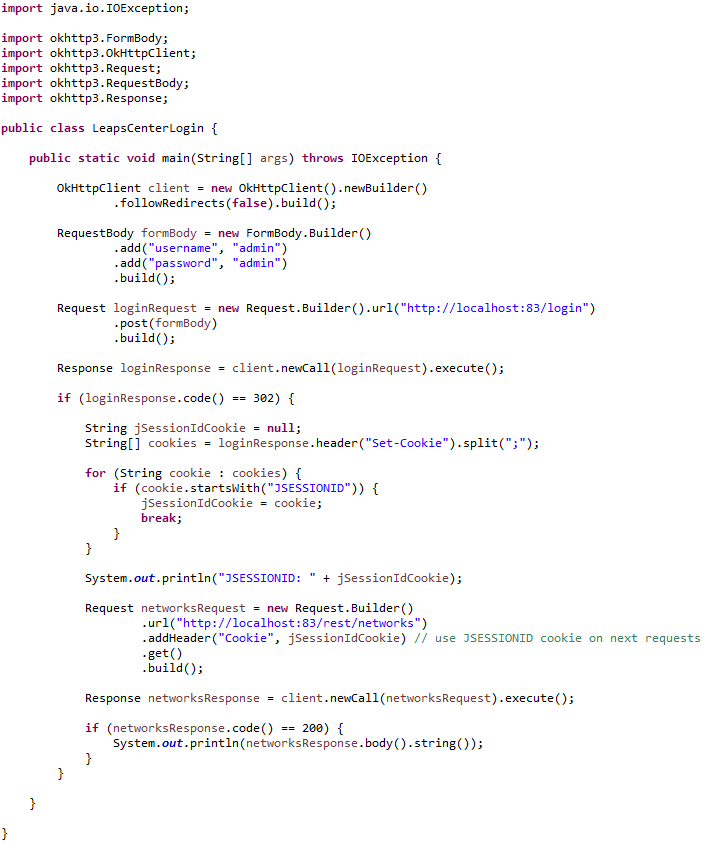
更多详情,请参阅以下两段视频,一段使用 Postman,另一段使用 Java 代码
